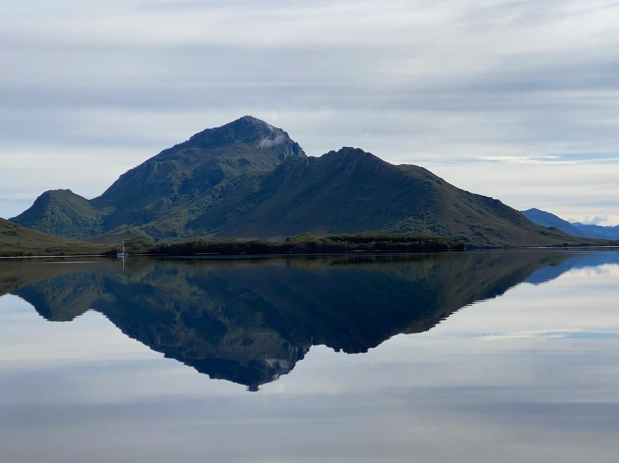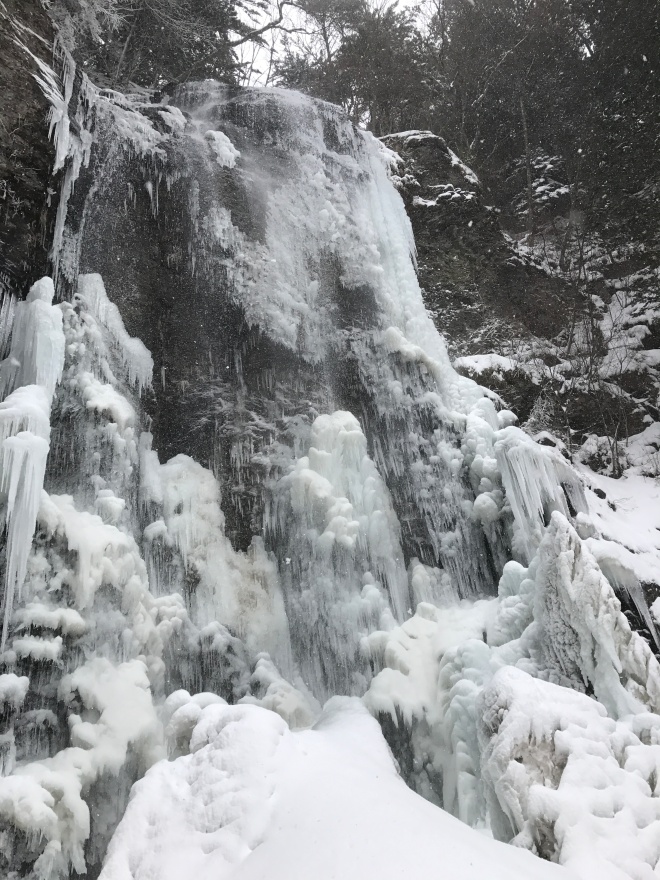At 600,000 hectares the UNESCO-listed Southwest National Park is Tasmania’s largest, famed for its wild rivers, impressive water bodies, jagged mountain ranges, button grass moorlands, ancient rainforest and myriad plant and animal species. It is a spectacular and truly elemental place, with wild and changeable weather the norm. The region encompassed by the Park has an extraordinary history of human habitation by Aboriginal Nations, reaching back tens of thousands of years. More recently intrepid individuals such as the Kings and the Claytons, who lived permanently in the region, have sparked people’s imagination. Part of the larger Tasmanian Wilderness World Heritage Area, there are many stories to tell about the southwest. On Earth Day 2021, my reflections focus on a day trip from Hobart to the region by plane and boat in mid-April 2021.
Water
Elemental immersion on the Overland Track, Tasmania
Walking the Overland Track in Tasmania was transformative. At the completion of the six-day, 80 km walk my body felt infused to the core with wild nature. This sense of peace, pureness and oneness with life was singularly special. Indigenous Tasmanians, early Europeans, hikers, ‘influencers’ like Sarah Wilson, and many others have traversed the ancient, rugged and awe-inspiring landscape before me. Each person responds to the energy and pull of this place in their own way. My experience was fully immersive in the capricious elements for which the high country is renowned. At the close of each day I intuitively chose which element had captured my spirit the most. On returning home, it was timely to reflect on the local and global environmental changes that have occurred since the walking track was formalised in 1931. The extent and magnitude of these changes challenge the conservation and protection of this rare and precious World Heritage site like at no other time.
Shinto Moments on the Three Capes Track, Tasmania
Awakening to a glorious sunrise over Munro Bight was one of many unforgettable experiences on a recent four day trek in SE Tasmania, Australia. There is something universally uplifting about the rising sun, especially when vibrant colours fill the sky. Like rainbows, they touch the soul and make you feel grateful to be alive. Spending several days experiencing the awe and wonder of the Three Capes region was a privilege, especially in Spring. By good fortune I had read the book ‘Shinto Moments‘ just before departing. The perspectives it contained were both complementary and contrasting to ‘Encounters on the Edge‘, the guide provided for the Three Capes Track.
The interplay of fire, water, eucalypts and light
Once-upon-a-time – nearly 30 years ago to be more precise – a lone eucalypt seedling taught me an important lesson. The seedling was part of a major research project I was undertaking in Canberra, Australia on the response of eucalypts to fire. I had planted the seedling on a north-facing slope (which receives the most sunlight in the southern hemisphere) and it was growing much better than other seedlings nearby. Why was this so? The answer was a surprise. If I hadn’t had access to specialist equipment, I probably would still be wondering. It turned out that the interplay between fire, water and light was critical to the impressive growth of this seedling, as well as affecting the 1000 or so eucalypt trees I monitored for 18 months after the fire. Learning more about the inner-workings of these incredible plants reinforced the inter-connectedness of everything, and opened the door to further post-fire studies in Malibu, California. Looking back, it is safe to say this one eucalypt seedling changed the course of my life.
Woman on Fire: Insights from an Elemental Career
On November 29th, 2019 I was awarded the prestigious Ecological Society of Australia (ESA) Gold Medal for my substantial contribution to ecology in Australia. The title of the Plenary Address was ‘Woman on Fire: Insights from an Elemental Career‘.
The slides and text following the introductory image below were used in the award presentation at the ESA conference in Launceston, Tasmania. Some additional information is provided in this blog, as well as links to the programs and publications referred to in the presentation. The post is around 5000 words in length, so find a comfy chair, grab your favourite drink, relax and read on.
Volcanoes: nature’s elemental energy exemplified
Vulcanoes are vents in the earth’s crust through which pent-up energy and molten material is released from the interior. Deriving their name from Vulcan, the Roman God of Fire, volcanoes have been treated with awe and respect over human history. With their explosive energy and fiery antics they are the poster-child of books and media related to Planet Earth, ‘natural’ disasters and incredible adventures. My first encounter with these shapers of the earth was in Hawaii. It was there that I fell under the spell of Pele, the Hawaiian Goddess of Volcanoes – one of many gods associated with volcanoes around the globe. Created by passing over a submerged volcanic hotspot, both the Hawaiian Islands and the Galapagos are testament to the constantly moving nature of the earths surface. On land the Pacific ‘Ring of Fire’ exemplifies the clustering of volcanoes along the boundaries of mobile tectonic plates. While fire and volcanoes are synonymous, the elements of water, air and earth also play a fundamental role in the birth and expression of these conduits of energy. The creation, impact and flow-on effects of volcanoes on our lives makes a fascinating and sometimes surprising story.
Earthing, energy and the elements
Our feet are amazing structures with powerful symbolism. They allow us to walk upright and can transport us towards or away from people, places and situations. Both feet and toes are associated with specific elements. In their barefoot state feet connect us to the energy of the earth – an ancient bond being reborn in modern times as ‘Earthing’. Acupuncture meridians starting in the feet connect our energy points internally. Reflexology and Applied Kinesiology also work with feet, energy flow and the five elements. These relationships highlight the importance of feet to our well-being. They may also help explain why feet feature in many phrases about how people feel and behave. Welcome to the fascinating world of feet, energy and the elements.
Mountains as teachers
Nature is a powerful teacher, especially if we pay close attention and use our full range of senses. In the UN International Year of Soils (2015) I wrote about the soil as teacher. In 2018 I pay homage to mountains as teachers by sharing a recent and remarkable experience in Japan. Led by three Shugendo masters, the two day pilgrimage I joined on Mt Ontake in January 2018 was extraordinary. The energy of the mountain, forests, snow and waterfalls was palpable. First published on my sister blog ‘elementaljapan.com‘, here is the link to ‘Shugendo now – a winter pilgrimage on Mt Ontake, Japan.’
The artistry of elemental Tasmania
Tasmania is renowned for its natural beauty, fine food and wine and its vibrant arts scene. This elemental island has inspired artists for tens of thousands of years, the story beginning with Aboriginal Tasmanians. Contemporary artists continue to be inspired by the elements, with a growing trend to immerse materials in the elements themselves – earth, water, fire and air. As an elemental place, Tasmania speaks to me of fire and water. Others respond to the elements in the island State in their own way. Photographs are used as the story-teller in this post. The perfect medium when capturing the artistry of elemental Tasmania.
Learning the “Ah” of air
Breathing is a wonder we take for granted. This is the first sentence of the essay titled AIR by Alan P Tory in his book ‘WONDER. Learning the “Ah” of things‘. I was struck by the poetic language that Alan uses and by the wise words of a Zen Master he shares, that we must learn to understand the “Ah” of things. To admire the works of art that surround us in everyday life. Through images, sound and excerpts of Alan’s text it is my turn to share the “Ah” of Air.


